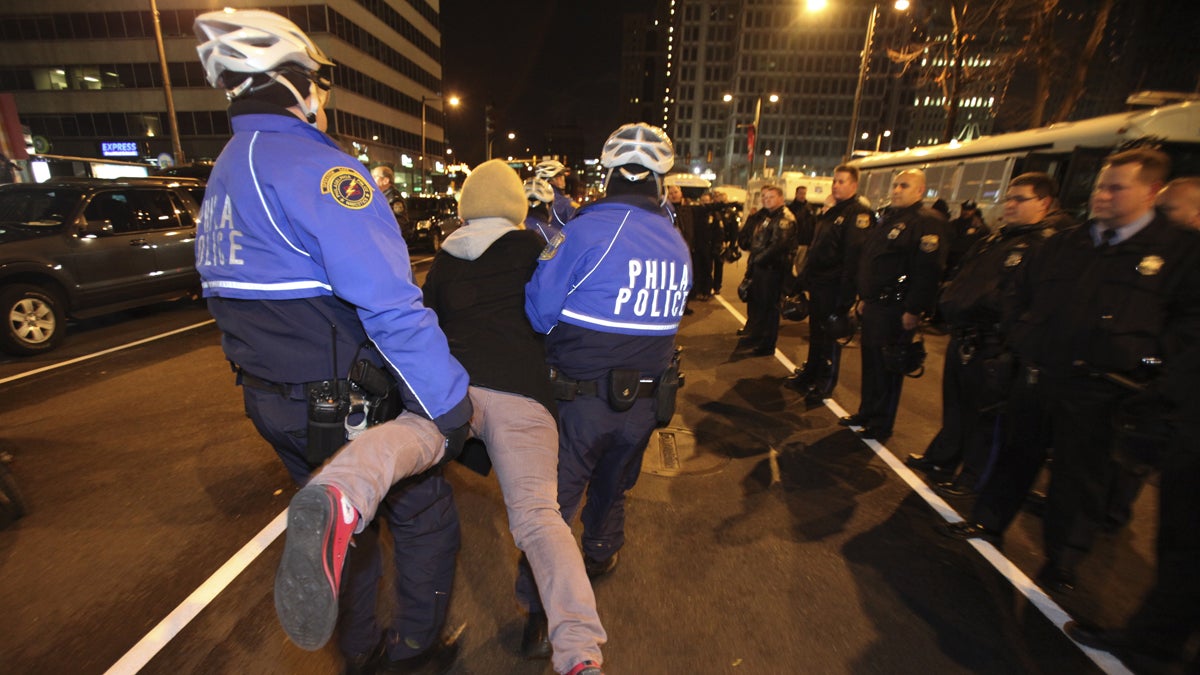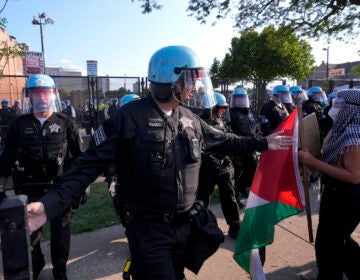Timeline: A history of Philly protests
The roots of dissent run deep in Philadelphia.

(Matt Rourke/Associated Press)
The roots of dissent run deep in Philadelphia.
In 1727, the city’s most famous forefather, Benjamin Franklin, wrote: “Freedom of speech is a principal pillar of a free government; when this support is taken away, the constitution of a free society is dissolved, and tyranny is erected on its ruins.”
Since then, throngs of discontented Philadelphians have taken to the streets to air their grievances.
Check out our timeline for a look at some of Philadelphia’s more notable protest moments.
1800 — 2016
LABOR PROTESTS
Giant inflatable rats and Johnny Doc (IBEW Local 98’s brash business manager John Dougherty) may be what leap to mind when you think about labor issues here, but Philadelphia’s labor activism dates back decades, from strikes by shoemakers, carpenters, bookbinders, and textiles workers in the 1800s to a trolley workers’ strike in 1910 that exploded into a citywide riot to a 1972 teachers strike that led to union leaders getting jailed. Most recently, activists from groups like Fight for $15 have focused on helping low-wage workers climb out of poverty by calling on lawmakers to boost the minimum wage to a “liveable” $15 per hour.
AUGUST 28, 1964 — AUGUST 30, 1964
RACE RIOT ON COLUMBIA AVENUE
It started with a fight over a broken-down car on a sultry summer night in North Philadelphia. After two officers argued with the black driver who couldn’t move it, a large crowd gathered – and the cops ended up arresting both the driver and a man who came to her defense. Rumors flew that police had beaten a pregnant black woman, and unrest erupted into a three-day riot that ended in hundreds of arrests and injuries, and property damage to hundreds of buildings. But beyond the vandalism and looting, this was, at heart, a protest over racism and police brutality. Long-simmering anger at officers’ heavy-handed, racist policing tactics and several well-publicized brutality incidents converged with a national shift to more confrontational protests. Many businesses never recovered, and some blame the riots for hastening white flight and boosting the notoriously tough-on-crime Frank Rizzo to power.
JULY 4, 1965 — 1969
LBGT PROTESTS
Philadelphia played a central role in the beginning of the gay-rights movement: It hosted the first major American protest for LGBT equality outside Independence Hall. About 40 picketers marched in front of Independence Hall and the Liberty Bell, marking the first time gay activists from multiple cities got together to publicly rally for gay rights. Dubbed “the Annual Reminders,” the protests continued every Independence Day until 1969, when the Stonewall riots shifted activists’ focus to New York City. The organizers of the Annual Reminders celebrated the Stonewall riots’ anniversary in 1970, and that evolved into annual gay-pride parades. Gay activism resurged in the early 1990s in Philadelphia, when anger over the AIDS epidemic drove many to stage awareness-raising protests and die-ins.

JULY 31, 2000 — AUGUST 3, 2000
RNC PROTESTS
Thousands of protesters came to town when GOP presidential nominee George Bush headlined the 2000 Republican National Convention. But it was how the police handled them, rather than their protest activities and messages, that became the stuff of headlines – and lawsuits. Before the convention, undercover officers infiltrated activist groups to spy on them, and police raided and closed a warehouse where activists strategized and built props. During the RNC, authorities corralled protesters in “free-speech zones,” and police arrested more than 400 of them, with judges jailing some on $1 million bail. Most of those arrested were later acquitted and filed civil-rights lawsuits that the city’s insurer paid $1.8 million to resolve.

2008 — 2016
ANTI-FRACKING PROTESTS
For many Philadelphians, fracking seems as foreign as chicken cheesesteaks – an environmental issue plaguing only faraway places where the drilling happens, like Dimock, Towanda and other unfamiliar burgs. But the state’s anti-fracking movement actually began here, with Delaware Riverkeeper Maya Van Rossum, who has been fighting to keep gas rigs out of eastern Pennsylvania since 2008. More recently, environmentalists here have battled a proposed natural gas liquids pipeline to Marcus Hook and plans to privatize the city’s utility, the Philadelphia Gas Works.

OCTOBER 2011 — APRIL 2016
OCCUPY PHILADELPHIA
The Occupy movement, which protests social and economic inequality around the world, made its mark on Philadelphia when about 300 people set up camp for seven weeks in Dilworth Plaza outside City Hall to draw attention to income equality. On Nov. 30, 2011, police booted the protesters from the plaza, on the mayor’s order, so workers could start a scheduled $50 million renovation of the plaza. But the night ended in the arrests of more than 50 campers, who took their protest to the streets. All were eventually acquitted – and some then sued the city for violating their free-speech rights. The city agreed last April to pay $200,000 to settle claims it violated protesters’ civil rights.

2014 — 2016
YOUTH ACTIVISM
City kids have plenty to protest, and in recent years, they’ve made their voices heard. From silent die-ins to decry police brutality to raucous rallies to protest school budget cuts, students in their teens and even younger have joined older activists to promote their causes or held actions on their own. One student, 13, even got arrested last month when he and other activists blocked an expressway ramp in Center City to protest anti-immigration policies. Several groups, including the Philadelphia Student Union and Youth United for Change, have formed to facilitate youth activism here.

2014 — 2016
TAXI PROTESTS
Who hasn’t been stuck in traffic behind a cabbie stopping to drop off or retrieve a rider? But since the unregulated ride-sharing services Uber and Lyft came to town, Philadelphia’s cabbies and limo drivers have intentionally blocked traffic with several horn-honking protests, circling City Hall and snaking through Center City. If they have to follow the rules, they argued, so should Lyft, Uber and other such car services. The dispute remains unresolved, and taxi drivers have threatened to strike during this week’s Democratic National Convention.

DECEMBER 2014 — 2016
BLACK LIVES MATTER
Although the Black Lives Matter movement began with the 2012 slaying of teenager Trayvon Martin in Florida, it quickly spread to other cities – including Philadelphia, where early Black Lives Matter actions targeted police brutality and criminal injustice. When a police officer gunned down Brandon Tate Brown during a routine traffic stop in Frankford, critics marched weekly for months to call for a federal investigation into his death. Activists here also rallied around a federal Justice Department study in March 2015 that found that police-involved shootings had risen even as crime overall dropped, cementing longstanding distrust in the community.
WHYY is your source for fact-based, in-depth journalism and information. As a nonprofit organization, we rely on financial support from readers like you. Please give today.



